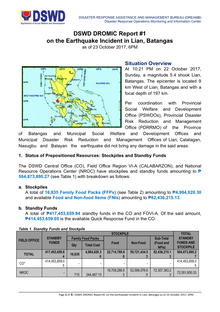
21 Sep, 2025
3 min read
Moody’s Predicts 5.7% Economic Growth for Philippines Amid Fiscal Challenges
The Philippine economy is projected to expand by 5.7% in 2024, driven by robust household consumption, steady remittance inflows, and continued public investment, according to Moody’s Investors Service. This forecast aligns with the government’s updated GDP growth target of 5.5% to 6.5% for the year.
In its latest credit rating review, Moody’s highlighted that the country's economic momentum remains strong compared to regional peers, with second-quarter GDP growing 5.5% year-on-year, slightly above the first quarter’s 5.4% but lower than last year’s 6.5% growth in the same period. The average growth for the first half of 2024 stood at 5.4%, down from 6.2% a year earlier.
However, Moody’s pointed to several downside risks that could temper this growth trajectory. Uncertainty surrounding U.S. trade policies represents a key challenge, particularly following the imposition of a 19% tariff on Philippine exports to the U.S. since August 7. Despite the nation’s relatively low integration into global value chains, such external factors may affect domestic investment and consumption.
Fiscal consolidation efforts are progressing, with the government targeting a deficit reduction to 4.3% of GDP by 2028 under its Medium-Term Fiscal Framework. Enhanced revenue collection and spending efficiency reforms are instrumental in this effort. Yet, Moody’s warned that the country’s elevated debt levels and interest expenses remain significant concerns.
As of June 2024, the Philippines’ sovereign debt reached a new peak of ₱17.27 trillion, up 11.5% from the same month the previous year, pushing the debt-to-GDP ratio to 63.1%, the highest since 2005 and exceeding the 60% threshold considered manageable by multilateral lenders.
The agency expects debt servicing costs to strain government finances over the next two years before gradually improving as global refinancing rates decline and economic growth stabilizes. The central bank’s policy easing—totaling a 150-basis-point reduction in borrowing costs since August 2023—has yet to fully alleviate the elevated interest burden due to delayed transmission effects.
Despite these challenges, Moody’s noted the Philippines’ strong access to domestic and international financing and large foreign currency reserves as buffers against global capital flow volatility.
Moody’s reaffirmed the country’s “Baa2” credit rating with a stable outlook in August 2024, balancing potential growth opportunities against risks such as fiscal slippages, geopolitical tensions, and climate vulnerabilities. The Philippines received an “a3” rating for economic strength, reflecting its growth potential tempered by lower per capita income and exposure to climate risks.
Institutional and governance ratings stand at “Baa1,” signaling moderate governance challenges alongside sound macroeconomic policies. The “Ba1” fiscal strength rating reflects concerns over government debt and rising funding costs.
The rating agency suggested that sustained strong growth and improved fiscal management could bolster the country’s creditworthiness in the future. Moody’s stated, "Upward pressure on the rating would likely be driven by a more rapid improvement in fiscal and government debt metrics than we currently expect, indicating sustained trend recovery from the deterioration caused by the pandemic shock."
The central bank welcomed Moody’s positive outlook, with BSP Governor Eli M. Remolona, Jr. affirming, "The Philippines has built ample reserves and policy space to absorb external shocks, allowing us to maintain stability even in times of global uncertainty."
Recommended For You
Quezon City Experiences Record-Breaking Rainfall, Floods 36 Barangays
Sep 21, 2025
Paolo Benitez

CinePanalo Film Festival 2026 Opens Submissions with Expanded Genre Scope and Record Grants
Sep 21, 2025
Ana Marie Gonzales

3.6-Magnitude Earthquake Hits Off Calatagan, Batangas
Sep 21, 2025
Paolo Benitez

Jin of BTS Sets New Records with Solo Tour
Sep 21, 2025
Jose Reyes
